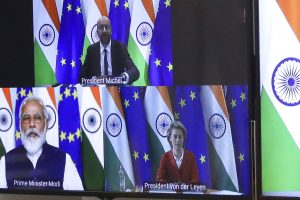In the background of a devastating second wave of COVID-19 in India, and just a couple of weeks after the European Union adopted Council Conclusions on a strategy for the Indo-Pacific, the EU-India virtual leaders’ meeting on May 8 has been anticipated as no other event of this sort. This summit is set to be the breakthrough so long awaited.
Recent summits have gradually built momentum, with the last summit in July 2020 endorsing a “Roadmap to 2025.” The document was considered instrumental for setting the strategic partnership on the right track to reach its full potential.
And this could well be happening. In the months following the summit, the EU and India held high-level meetings at unprecedented speed. The two sides are seeking to strengthen cooperation on maritime security and artificial intelligence, relaunch trade negotiations, and resume dialogue on human rights after an eight-year halt. While such high-level meetings are a routine exercise in preparing for summits, they are exceptional for EU-India observers, who are rather used to political neglect.
Geopolitical and geoeconomic considerations, spearheaded by the ongoing security and economic dynamics in the Indo-Pacific and by sustained economic interests, have made the breakthrough possible. India’s last-minute withdrawal from the Regional Comprehensive Economic Partnership last year – because of its potential to further increase India’s chronic trade deficit with China – may have pushed India further to the West, and toward economic integration with the EU.
For the EU, the progress toward a free trade agreement (FTA) comes amid its active efforts to bolster trade links with Asian countries. The rise of China as a global player has also played a role in accelerating and deepening the strategic partnership. President Joe Biden’s willingness to join hands with other democracies and invest in technology to counter China’s Belt and Road Initiative (BRI) may have been the final push.
For the first time, the strategic partners are set to hold a summit presenting concrete outcomes. Two of the most anticipated ones are the connectivity partnership and reopening of FTA negotiations. Both will bring substantial advances in joint cooperation.
On the first count, the EU started to envisage connectivity as foreign policy tool in 2018, adopting a connectivity strategy for Asia to provide a sustainable and value-based alternative to the BRI. The EU-Japan connectivity partnership was formed just a year later in 2019, serving as a template for future bilateral connectivity partnerships. In January 2021, connectivity gained additional traction with a European Parliament report calling for expansion of the connectivity strategy into a global one.
The EU and India are now expected to embark on a connectivity partnership. To have an impact, it will have to go beyond joint statements and provide details on specific measures and how they will be funded. We all know that infrastructure needs in Asia are in the order of trillions. No public entity will be able to face it alone; constructive cooperation is needed with the private sector. The way this new modus operandi unfolds will have a tremendous effect on how EU foreign policy is conducted and perceived by the receiving entity.
Regarding a possible FTA, the EU and India initiated trade negotiations in 2007 but then suspended negotiations in 2013. The lack of progress on the trade file weighed heavily on the overall strategic partnership, which lost ground. While EU-India economic relations have been capable of flourishing despite the lack of an FTA (see the infographic by EPRS), an FTA would unlock the economic and political potential of the strategic partnership and have significant geopolitical ramifications.
What’s next? On May 4, EU High Representative Josep Borrell and India’s External Affairs Minister S. Jaishankar issued a joint statement on Afghanistan, showing that the EU and India can align their foreign policy on issues of common concern. It would be good to see more such statements, including on issues of global concern like climate change.
However, with this summit the strategic partners leave the era of joint statements to enter one of joint action. Implementation of the connectivity partnership will set a new course for conducting foreign policy in a joint manner. The reopening of FTA negotiations will boost confidence. How the EU and India will cooperate in the region, bilaterally as well as multilaterally, will define their global standing and credibility.

































